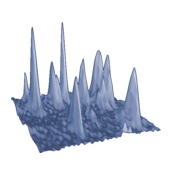Michel Orrit Lab - Single Molecule Optics
Since the early 1990s, one can isolate the optical signal of a single molecule and single-molecule spectroscopy has quickly grown into an important research field.
Not only is single-molecule detection the ultimate limit of chemical analysis, it also offers data free from any form of averaging over populations, providing information about molecular electronic structure and photophysics with unprecedented detail.
A single molecule can be seen as a well-defined two-level system interacting with laser fields. It is therefore a nice object for nonlinear and quantum optical experiments. A single molecule is also small, often less than a nanometer in size. It can thus serve as a small probe for structure and dynamics of its condensed environment on a local scale of 1 to 100 nanometers.
Our aims are to demonstrate and establish optical methods giving access to the nano-world, and to apply them to problems in physical chemistry, materials science, and biomolecular science.
News
Key publications
-
Zijlstra P., Paulo P.M.R. & Orrit M.A.G.J. (2012), Optical detection of single non-absorbing molecules using the surface plasmon resonance of a gold nanorod, Nature Nanotechnology 7: 379-382.
-
Gaiduk A., Yorulmaz M.Y., Ruijgrok P.V. & Orrit M.A.G.J. (2010), Room-temperature detection of a single molecule's absorption by photothermal contrast, SCIENCE 330: 353-356.
-
Boyer D., Tamarat Ph., Maali A., Lounis B. & Orrit M.A.G.J. (2002), Photothermal imaging of nano-meter-sized metal particles among scatterers, SCIENCE 297: 1160-1163.
-
Illuminating Single Molecules in Condensed Matter, W. E. Moerner, M. Orrit, Science 283 (1999) 1670.
-
Single Pentacene Molecules Detected by Fluorescence Excitation in a Para-terphenyl Crystal, M. Orrit, J. Bernard, Physical Review Letters 21 (1990) 2716.






